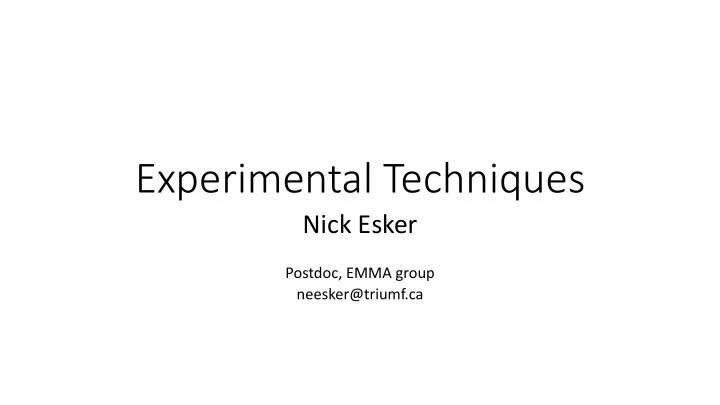

Experimental Techniques Nick Esker Postdoc, EMMA group neesker@triumf.ca
Three sessions for all detection schemes….. • My Goal: This is a very large area of active research, with ~100 years of history from Roentgen & the Curies to present. I want you all to be able to tackle a modern experiment without getting too distracted / off- put by the “how” • Three sessions IS NOT ENOUGH!!!! I’m purposefully ignoring: • Accelerators, reactors • Relativistic effects • Electronics / DAQ • Statistics
How this’ll work • We’ve a lot of material to cover. Too much. • I’m a strong believer in “active learning” • 40-50 min of lecturing (with plenty of questions ) • 10-15 min of small group activity, working on some toy problems • PLEASE ASK QUESTIONS!!!! • Resources: • Knoll: Nuclear Instrumentation • Krane: Nuclear Physics
The Plan TM Day 1 – Nov 6 Day 2 – Nov 15 Day 3 – Nov 17 • Radiation interaction • Manipulating matter • Charge particles with matter counting w/ gas • E and B fields • α, β , γ , n 0 , SF decay • Geiger-Mueller • lasers • Scintillators • Prop. counters • Examples • Semiconductors • Organic • Recoil separators • Inorganic • Si detectors • Traps • Light detectors • HPGe detectors • Potpourri • Examples at TRIUMF • PMT, MCP • Active targets • Examples at TRIUMF • 0 νν detectors • HE calorimeters
Ionizing radiation’s interaction with matter • Sources of ionizing radiation? • Accelerators and Reactors (& HE lasers) • Multiple secondary sources • Nuclear decay • α, β , γ , n 0 , SF decay
Nuclear decay • α • β • γ • n 0 • SF
Nuclear decay
“Heavy” charged ions 10 MeV / u, Z beam = 6,7,8,10,18
“Heavy”, charged ions • Bragg Curve • Energy ( E ), range in matter ( x ), and timing ( t ) are all affected by straggling, which widen their distributions
Believing Bragg by Bethe-Bloch
Beyond heavy… • e -
Photons and matter
Photons and matter • Three regimes
n 0 interactions • Elastic collision with the nucleus • Capture cross section dependent • Look for secondary forms of radiation
E deposited in matter • So, at this point, we’ve covered a couple general ways to deposit E of our ionizing radiation into some material. Once it’s there, how can we detect it?
Scintillating • What makes a good scintillator?
Scintillators • Organic • Inorganic
Efficiency of scintillation
Detecting Light - PMT
Detecting Light - MCP
Concluding remarks
Active scintillators @ TRIUMF • DRAGON’s gas target
Active scintillators @ TRIUMF • DESCANT neutron detectors
Exercise 1. Calculate the scintillation efficiency of anthracene if a 1.5 MeV alpha particle is stopped in the medium, which created 20,300 photons with average wavelength of 447 nm 2. Starting from the full Bethe-Bloch, derive the non-relativistic Bethe-Bloch from the lecture 3. An ion chamber with parallel plate electrodes, spaced 5 cm apart, is filled with methane up to 1 atm and operated at 1 kV. Knowing the W -value of methane (27.3 eV/ ion pair), calculate the maximum e collection time. (Might need to look up mobility of ions in electric field, gas)
Recommend
More recommend